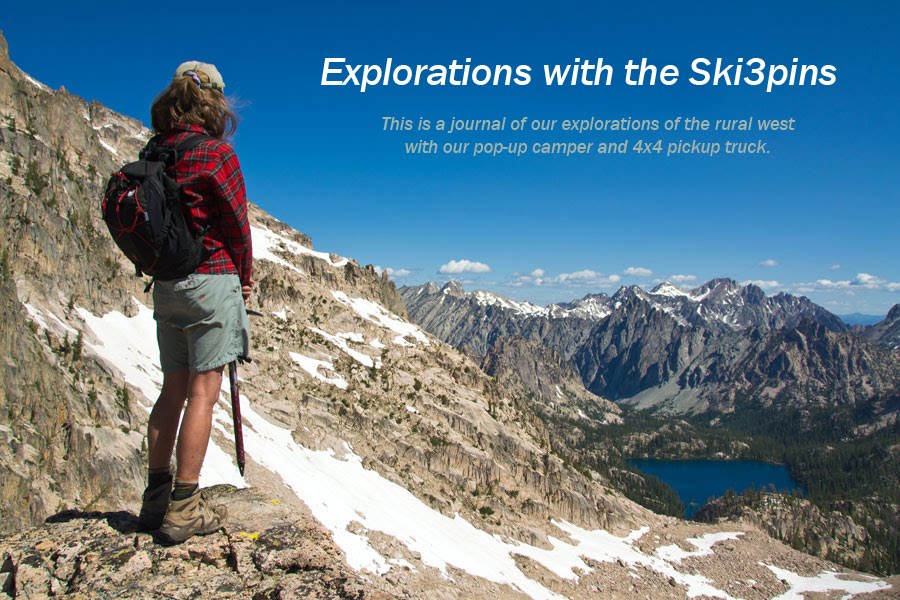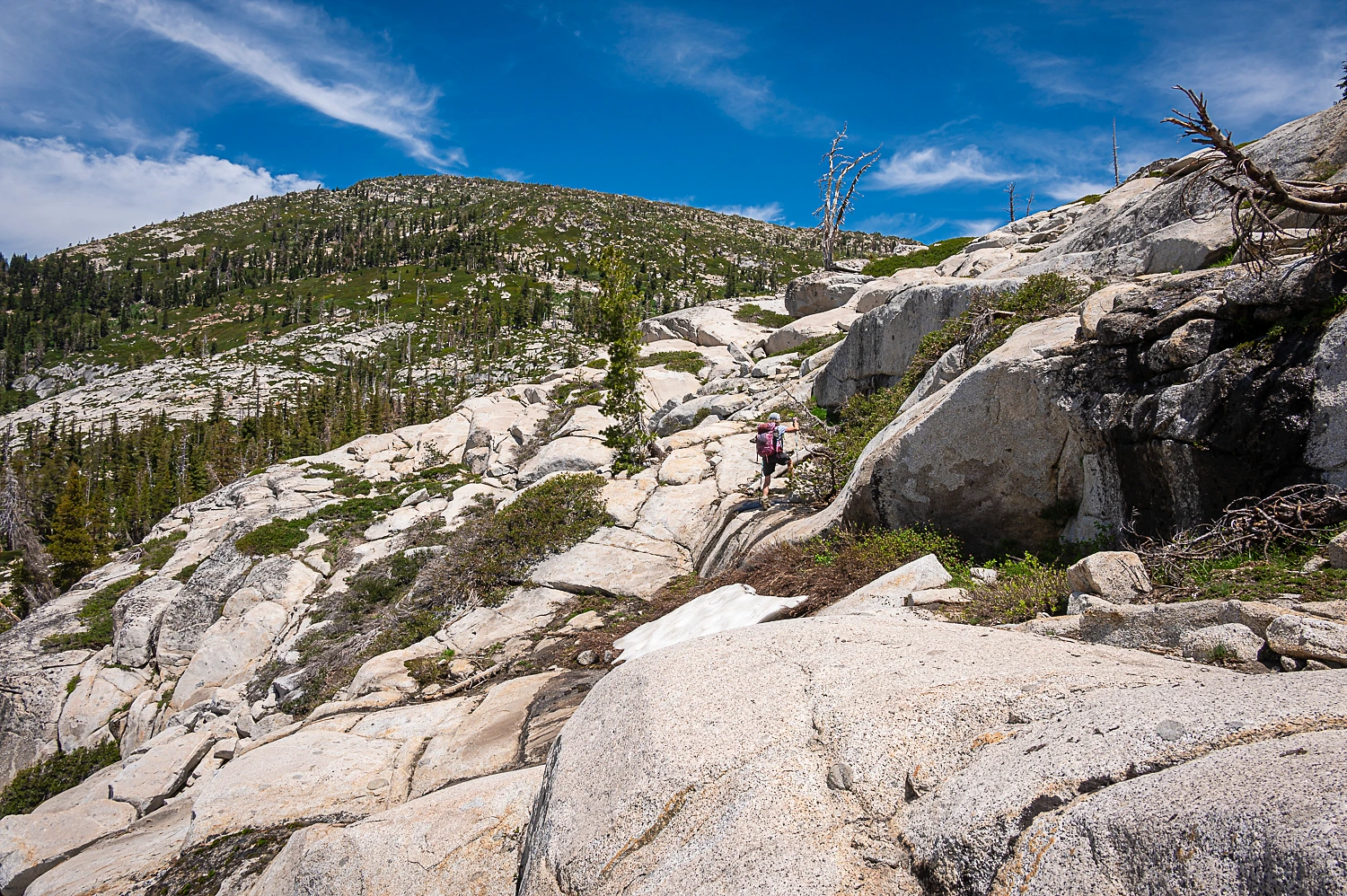please remember you can click on a photo to see a larger
version & highlighted text are links to additional information
Beating the Heat
June this year was one of the coolest Junes in our memories. We arrived back home from our last trip on the 2nd of July and the weather had turned blisteringly hot. Our pleasantly cool June was over. Here at home, when the temps get into the upper eighties and into the nineties, it is hot. The easiest solution for us to cool off is to go high, higher up into the Sierra Nevada.
The Lady did a solo hike on July 12th up at Carson Pass and into the Mokelumne Wilderness.
A fun note – the photographs used on the linked Wilderness webpage are mine.
She hiked out to Winnemucca Lake. Much of the terrain and part of the lake surface were still snow covered.
She wanted to do one of our favorite loop hikes, but the trail up to Round Top Lake was still covered with snow.
She gave me a call at home to tell me she would return to the trailhead at Carson Pass and then drive over to the Shealor Lake trailhead and do that short hike also. She did not take any photos of Shealor Lake. She is getting quite good with photos with her phone as the first two photos show.
An update: The Lady spent July 28th hiking with a friend out to Fourth of July Lake in the Mokelumne Wilderness from Carson Pass. Our friend works as a Wilderness Volunteer. Her report is that snow is now gone from around Winnemucca Lake and there are only a couple of patches on the trail up to Round Top Lake.
The weekend of the 15th & 16th of July was a real scorcher. Half way through it, we knew we had to get up in elevation for relief from the heat but also for some spectacular high-country visuals. One of our favorite backpacking destinations in our nearby Desolation Wilderness was Lake Number Three. It’s a bit over seven miles in from the Van Vleck Trailhead.
The first several miles are fairly level through timber interspersed with meadows.
We expected the water to be high from our exceptional snowpack this past winter. We carried wading scandals with us.
The Lady changed into her scandals for the first crossing of Bassi Fork.
We are fairly tolerant of mosquitoes but today the little bloodsuckers were almost unbearable. As soon as we exited our vehicle at the trailhead a shout must have gone out to the pestering hordes, “Fresh meat!” We reapplied bug juice often and wished we had our – as a last resort – 100% Deet along.
It's a few miles in before we crossed the Wilderness Boundary.
In the wet meadows the Camas Lilies (Camassia quamash) were showing off.
After entering the Wilderness, the trail climbs glacial rubble, moraines left behind after the last glaciers retreated.
Thoughts of our hot weather vanished when we entered the ice-cold water at the second ford of the Bassi Fork.
The meadow areas in the lodgepole pine were wet and in many places inches deep with standing water. Patches of snow remained also. To stay dry we left the trail and took a direct route up an open granite slope. The Lady was more than up to the challenge.
Lake Number Three sits below Red Peak, so when the peak came into view our direction of travel was confirmed. Up high, we were also crossing large snowfields. Spring time is just arriving up here.
Red Peak above Lake Number Three with the abundant Mountain Heather (Phyllodoce breweri) in bloom.
More than half of the lake shore was still snow covered.
This is a seldom visited part of Desolation Wilderness and is good, if like us, you are after solitude. We saw only one other person - and this was further down country and not up here in the snow. After a nice break, snack, and filtering water to refill our bottles, we turned back to the trailhead. On our return we attempted to follow the trail to check its condition. The timbered drainage it descends was completely snow covered. With our familiarity with the area, we knew where the trail runs, but with deep snow on steep timbered slopes, we were careful. We finally broke out into the open.
A few miles later and we were back to the large meadows. With the afternoon light, Red Peak was the prominent landmark on the crest of the Crystal Range.
We were back at our vehicle at 1800 hrs. As we drove out the single lane, and soon to be overgrown, Cheese Camp Road, the Lady remarked she’d sure like to see a bear. Right on cue a huge light cinnamon colored black bear with a distinctive dark chocolate colored face crossed the road right ahead of us. Its four paws were black with mud. I was so tempted to say something like this, “I’ll get the camera ready and why don’t you say you’d sure like to see bigfoot.”
It was a great day and a great hike. It sure beat staying home.
The relentless heat continued. The next weekend we, again, were seeking relief in the highest elevations. Sunday, July 23rd, found us back up at Carson Pass and the Meiss Trailhead on the north side of highway 88.
Meiss Country is not designated Wilderness but is a special non-mechanized area managed by the USFS Lake Tahoe Management Unit to protect the headwaters of the Truckee River (Upper Truckee River here) that flows into Lake Tahoe, and then into the Great Basin and Pyramid Lake.
From the trailhead we headed north on the Pacific Crest Trail (PCT).
Our section of the Sierra Nevada has magnificent Sierra Juniper (Juniperus grandis)
The PCT climbs to the top of, what we call, Meiss Saddle. The views are outstanding as you climb and you can see why we love this place.
Meiss Saddle is the boundary between the Pacific drainage and the Great Basin. Continuing north, we dropped into the headwaters of the Truckee River.
Yes, that is the beautiful expanse of Lake Tahoe in the far distance.
The Lady crossed the beginnings of the (Upper) Truckee River.
The broad Meiss Meadow is very special.
The historic Meiss Cabin.
The information sign has become very faded.
This is how it reads –
“The Meiss cabin was built by California pioneer Louis Meiss, who emigrated from Hesse Darmstadt Germany with his parents in 1842. The Meiss’s moved west to Drytown, California by wagon train.
In 1878 he bought the 1000 acre Summit Range in Alpine County for summer grazing. This land included the present day Meiss Meadow. Along with their 2 sons and 8 daughters, Louis and Elizabeth built a two story frame cabin and log barn on the Meiss Meadow site. According to the dates carved into the walls, construction was completed around 1880.
At the turn of the twentieth century, Louis’ sons Benjamin and Frank began managing the ranch. After Louis’ death in 1905, Benjamin, his wife Jennie, and their four daughters continued the family tradition of summering at Meiss Meadow. One of their daughters, Evelyn Meiss recalls:
“My father …… drove his herd of cattle by horseback, taking five days, through Plymouth, Silver Lake, and Caples Lake …. To our range for the summer …. My three sisters and I had many a lovely summer fishing and riding horseback. Once a week some of us would ride our horses to Meyers to pick up our mail. It took us most of the day for the trip. My mother, in the meantime, would either make ice cream to be frozen in the snow bank or bake bread and biscuits in the wood stove.”
- Evelyn Meiss Richards, June 2001
The Meiss family sold the land and the cabin to the Schneider family in 1936. In 1965, the Forest Service acquired the land through a land exchange for public use.”
We have hiked into Meiss Country only a handful of times, but
we’ve backcountry skied into here an uncountable number of times over the last 35
years. We know this area better in the winter than we do in the summer. As examples -
Here we are following a large group at Meiss Saddle.
The top of the roof of the barn makes a great lunch spot. The Lady loves that old red vest of hers.
A friend of ours and one of the most interesting characters we have ever known, Dave Beck, had an outfitter guide permit to operate here that included use of the historic cabin in winter. Many times we'd stop in and check to see if Dave was around. The chimney on the wood stove never drew air well and the cabin was too smoky for us to want to go inside when Dave would invite us in. Dave gave us the combination for the lock so we could check on the cabin if he wasn't around and let him know of any issues.
Here's a well written article on Dave - David Beck: Architect of the Sierra High Route
Meiss Meadow in winter.
We continued on the Pacific Crest Trail as it climbed out of the meadow basin.
We turned off of the PCT at Showers Lake. This was a Sunday and there were several groups at the lake, including uncontrolled dogs and dogs allowed to bark incessantly. We quickly decided to bypass Showers Lake. I’m repeated reminded of the old joke – If I wanted to hear my neighbor’s dog bark, I didn’t need to drive a thousand miles. I could have stayed home. We climbed a snowfield to reach a highpoint with a view - a great place for a long break.
The above photo is a panorama of Showers Lake and Lake Tahoe.
We continued up this trail to the top of the ridge above us and around the remains of the large cornices that form along the lee side of this ridgeline in the winter.
The trail continues west and off the ridge, but a use trail runs along the top of the ridge and intersects with the PCT back at Meiss Saddle. We made use of this trail for a nice loop hike back to Carson Pass.
We were surprised with the abundance of Yellow Stonecrop (Sedum Lanceolatum)
Walking this ridge provides the best views of the Meiss area and beyond.
Here’s the view back to the north, the direction we came from.
And our route ahead to the south and intersect with the PCT at Meiss Saddle.
Wildflowers thrive on this windswept ridge of volcanic rock - Sulphur Buckwheat.
Mule Ears (Wyethia mollis) interspersed with lupine.
As we dropped down from the saddle and returned to the trailhead, we continued to take in the wildflowers - Indian Paintbrush.
This was yet another wonderful Sunday hike in the high country to escape the heat and get a little closer to heaven. This morning we saw an extended forecast that is predicting more record-breaking heat for August. We’ll need to go hang out with pikas to survive.















































